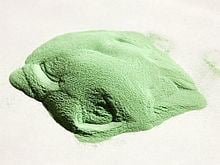Formula NiCO3 Density 4.39 g/cm³ | Molar mass 118.702 g/mol Appearance light green powder | |
 | ||
Nickel(II) carbonate describes one or a mixture of inorganic compounds containing nickel and carbonate. From the industrial perspective, the most important nickel carbonate is basic nickel carbonate with the formula Ni4CO3(OH)6(H2O)4. Simpler carbonates, ones more likely encountered in the laboratory, are NiCO3 and its hexahydrate. All are paramagnetic green solid containing Ni2+ cations. The basic carbonate is an intermediate in the hydrometallurgical purification of nickel from its ores and is used in electroplating of nickel.
Contents
Reactions
Nickel carbonates are hydrolyzed upon contact with aqueous acids to give solutions containing the ion [Ni(H2O)6]2+, liberating water and carbon dioxide in the process. Calcining (heating to drive off CO2 and water) of these carbonates gives nickel oxide:
NiCO3 → NiO + CO2The nature of the resulting oxide depends on the nature of the precursor. The oxide obtained from the basic carbonate is often most useful for catalysis.
Basic nickel carbonate can be made by treating solutions of nickel sulfate with sodium carbonate, shown here for the basic carbonate:
4 Ni2+ + CO32− + 6 OH− + 4 H2O → Ni4CO3(OH)6(H2O)4The hydrated carbonate has been prepared by electrolytic oxidation of nickel in the presence of carbon dioxide:
Ni + O + CO2 + 6 H2O → NiCO3(H2O)4Uses
Nickel carbonates are used in some ceramic applications and as precursors to catalysts.
Safety
It is moderately toxic and causes low irritation. Avoid prolonged contact.
